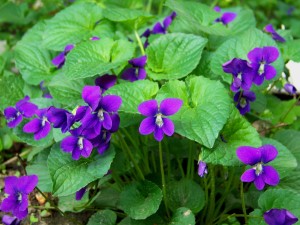Spring, Ayurvedically speaking

A few days ago, I was surprised by a patch of blooming violets in my backyard. In my body at least, it still feels like winter. But there they were, bravely bearing the variable temperatures and breezy days to put forth new growth. As if to reinforce the message that spring was on its way, an unlucky bird chose to make her home in my mailbox while I was away for the weekend. Regrettably, I cleared away the bits of worn leave and moss, presuming she was anticipating laying some eggs on my front porch.
New life, more warmth, increased hours of daylight … but what about the old, the cold, and the dark? Even those transitions we look forward to can be difficult, and the transition from winter to spring brings its own unique set of challenges. In spite of the vibrant energy outdoors, I find myself feeling stuck to my comfortable couch and cup of tea. The slow pace of winter meeting the dynamic pace of spring has created a laggard reluctance that leaves me tired and resistant. Unlike the shiny blue of new violet blossoms, I feel rather dull and listless.
So you get the idea, maybe you can even relate. But what can we do about it? Are we resigned to simply wait it out, believing that like the long nights of winter this too must simply be endured? Or just as we can embrace the restful time of winter, perhaps we can embrace the rapid changes and bursts of energy we see in nature during the spring.
 Ayurveda is a traditional holistic system of healing and healthy living that like yoga, originated in India. Within this framework for understanding the Self, three main doshas, or elemental substances, are present within the individual and also in nature. Often, one of these is dominant, but everyone has elements of all three that make up their unique body/mind self. In winter, the earthy, watery kapha is especially pervasive and supports eating and sleeping habits conducive to extra warmth for staying comfortable in colder temperatures and deep rest. Kapha in balance is associated with healthy joints, bones and muscles; patience and thoughtfulness; sound sleep and good digestion. But in spring, lingering kapha energy threatens to create imbalances in our bodies and minds. Too much kapha can result in lethargy and weight gain, or resistance to change and emotional dullness.
Ayurveda is a traditional holistic system of healing and healthy living that like yoga, originated in India. Within this framework for understanding the Self, three main doshas, or elemental substances, are present within the individual and also in nature. Often, one of these is dominant, but everyone has elements of all three that make up their unique body/mind self. In winter, the earthy, watery kapha is especially pervasive and supports eating and sleeping habits conducive to extra warmth for staying comfortable in colder temperatures and deep rest. Kapha in balance is associated with healthy joints, bones and muscles; patience and thoughtfulness; sound sleep and good digestion. But in spring, lingering kapha energy threatens to create imbalances in our bodies and minds. Too much kapha can result in lethargy and weight gain, or resistance to change and emotional dullness.
Fortunately, Ayurveda and Yoga offer us some guidance. By modifying our diet for spring (eating lighter, easy to digest foods, increasing our consumption of fresh fruits and vegetables), we can increase our digestive fire (agni) and decrease excess kapha. By practicing invigorating asana (think warrior sequences, sun salutations, backbends, and twists) and pranayama (try Kapalabhati and steady Ujjayi), we can begin to flush fresh prana throughout the body, rooting out stuck energy. And perhaps the most rewarding practice of all – attuning with the hum of nature all around us. Take a walk, pull some weeds and plant some herbs, or simply get up off that couch and park your asana on the front porch. But move slowly, awaken gently, choose your own mindful path to spring renewal.
